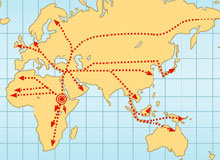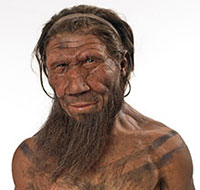Tracing our genetic ancestry
You need Adobe Flash Player, or an HTML5 enabled web browser, and JavaScript enabled to watch this video.
Visit the Adobe website to download the latest Adobe Flash Player
Scientists examining the evolutionary history recorded within our DNA are uncovering the global human story in greater detail.
Watch the film to discover what DNA analyses taught six well-known figures, including Bill Bailey and Alice Roberts, about their genetic ancestry.
DNA: the history book of humanity
There are currently around seven billion people living around the world. We each look and behave differently, a diversity that is also reflected at the genetic level. Our DNA changes through time, influenced by our environment and how we adapt to it.

Map of likely modern human migration routes through Africa, Asia and Europe. © University of California Museum of Paleontology and the Regents of the University of California
Scientists can use these differences to infer our origins and the routes our species took out of Africa as we populated the world.
Our origins
Alongside fossil and archaeological finds, genetic studies show that the different groups of people in the world today all originated in Africa. Our species, Homo sapiens, began to evolve there about 400,000 years ago. By 150,000 years ago some African fossils show clear modern human features.
Around 60,000 years ago, the first small groups of modern humans left Africa and began to disperse through Asia all the way to Australia, and also into Europe.
Studying DNA
Scientists study the evolutionary history in our DNA by examining parts of the genome present in every cell in our bodies.
DNA definitions
Mitochondrial DNA is found in tiny structures (mitochondria) in our cells that convert energy from food into a form cells can use.
Y chromosome DNA is contained in a sex-determining chromosome only found in the cells of men.
Nuclear DNA is packaged in 23 pairs of chromosomes in the nucleus of each human cell. One of each pair is inherited from the mother, the other from the father.
Genetic markers are specific DNA sequences whose location on the chromosome is known.
A simple cheek swab provides:
- mitochondrial DNA, passed from mother to child. Reveals information about your maternal lineage and where your mother's female ancestors may have lived.
- Y chromosome DNA (men only), passed from father to son. Reveals information about your paternal lineage and where your father's male ancestors may have lived.
- nuclear DNA, inherited from both parents. Reveals information about your ethnic ancestry and the percentage of any DNA inherited from Neanderthals or other extinct human species.
Researchers compare thousands of genetic markers within a person's DNA with those of other people across the world. The similarities and differences allow scientists to reconstruct population histories and estimate where our ancestors lived at certain times in the past.
A bit Neanderthal
As well as providing information about ethnic ancestry, Nuclear DNA reveals episodes of interbreeding between modern humans and other human species.

DNA research reveals the genetic legacy some of us have inherited from our extinct cousins, the Neanderthals.
When modern humans left Africa, they interbred with Neanderthal populations. This probably occurred in western Asia, and perhaps also elsewhere.
These events mean that non-African people today share around two per cent of their DNA with Neanderthals.
What does this DNA code for?
New findings suggest that some of the Neanderthal DNA is involved in producing skin and hair. The research teams speculate that it may have helped modern humans who left Africa to cope with the colder Eurasian climate.
Other Neanderthal DNA appears to be associated with an increased risk of developing certain diseases, including type 2 diabetes, and less tangible problems such as addictive behaviour and depression.
With further work, scientists hope to learn more about the implications of this shared heritage for people today.
Enjoy this video in HD
All of our Britain: One Million Years of the Human Story exhibition films are available in HD on YouTube.
Film participants traced their ancient ancestry by submitting their DNA to the National Geographic's Genographic Project. Explore the science behind the project.